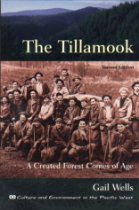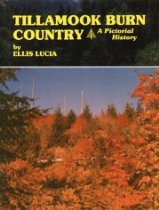Tillamook Burn
The historical marker on Oregon Highway 26 in the Clatsop State Forest
describes the Tillamook Burn best:
Oregon's Historic Tillamook Forest fire of 1933 spread over 240,000 acres of forest land. Fires in 1939 and 1945 brought the total to 355,000 acres over 13 billion board feet of timber were killed.
Devastation by these distratorus fires aroused Oregon voters to approve a bond issue for reforestation and protection of the burned area. Access roads were built and hazardous snags have been felled to improve forest protection. Many of these snags were sound: over seven billion boards feet have been salvaged., reforestation by planting and by aerial seeding includes Douglas Fir, Noble Fir, Sitka Spruce, Wester Red Cedar, and others.
A new forest will provide valuable wood and paper products, improved water storage, increased fish and wildlife and expanded outdoor recreation.
The Tillamook: A Created Forest Comes of Age
Debates over the fate of ancient forests have been commonplace in the Pacific West for decades. The Tillamook takes up the question of younger forests, exploring the creation of a managed forest and what its story reveals about the historic and future role of second-growth forests.
It was Oregon's most notorious conflagration-a series of four major fires that struck the Tillamook forest beginning in 1933 and recurred with bizarre regularity through 1951. The fires burned 355,000 acres of virgin forest and became collectively known as the Tillamook Burn. In this engaging history, Gail Wells recounts the story of these famous fires and the cooperative efforts of foresters and ordinary citizens-including thousands of schoolchildren-to get young trees growing again on the burned landscape. It became one of the largest forest rehabilitation efforts ever, resulting in a created forest that promised "timber forever."
Now a state forest, the Tillamook is coming of age at a time when attitudes toward forests have changed and "timber forever" is no longer the guiding principle. In contemplating the Tillamook's fate, Wells traces the historic roots of competing perspectives on forest use and examines the contemporary debate over forest issues. She sees the future of second-growth forests as holding the possibility of a workable synthesis, "a truly stable, sustainable, and humane relationship with our forests."
Tillamook Burn Country
The Tillamook Burn is known around the world as the scene of one of the greatest forest fires of all time. It is also known for the manner in which this sprawling, rugged corner of northwest Oregon was brought back to life and productivity after so many so-called authorities had said it could never happen.
Tillamook 1952
When the forest explodes, On August 24, 1933, Verlin Victory Lundigun, 32, catches a piece of pitch-fired flaming tree trunk with his face. He is one warrior among thousands fighting the fiercest forest fire in U.S. history the infamous Tillamook Burn. Verlin lives that day but is horribly scarred. He shields himself from the world with a black mask that cannot hide his rage. Nine months later he is dead from a gunshot. Verlin s death is accepted as accidental until his sister Iris dies in 1952. It is then that Iris youngest son makes a discovery that compels him to search for how and why his uncle died. Lou Kallander s quest rekindles old suspicions, guilt and his own long-dormant sense of self. When Lou confronts the people he thinks have insights into his uncle s death, they are not willing partners in his quest. His siblings, likewise, are opposed to Lou mucking around in the sour backwaters of the family s past. He also meets a woman who is housesitting the family home. They become attracted to each other but not without complications. TILLAMOOK 1952 is about sibling introspection, the pain of friendship, and a search for absolution.
Oregon's Historic Tillamook Forest fire of 1933 spread over 240,000 acres of forest land. Fires in 1939 and 1945 brought the total to 355,000 acres over 13 billion board feet of timber were killed.
Devastation by these distratorus fires aroused Oregon voters to approve a bond issue for reforestation and protection of the burned area. Access roads were built and hazardous snags have been felled to improve forest protection. Many of these snags were sound: over seven billion boards feet have been salvaged., reforestation by planting and by aerial seeding includes Douglas Fir, Noble Fir, Sitka Spruce, Wester Red Cedar, and others.
A new forest will provide valuable wood and paper products, improved water storage, increased fish and wildlife and expanded outdoor recreation.
The Tillamook: A Created Forest Comes of Age
Debates over the fate of ancient forests have been commonplace in the Pacific West for decades. The Tillamook takes up the question of younger forests, exploring the creation of a managed forest and what its story reveals about the historic and future role of second-growth forests.
It was Oregon's most notorious conflagration-a series of four major fires that struck the Tillamook forest beginning in 1933 and recurred with bizarre regularity through 1951. The fires burned 355,000 acres of virgin forest and became collectively known as the Tillamook Burn. In this engaging history, Gail Wells recounts the story of these famous fires and the cooperative efforts of foresters and ordinary citizens-including thousands of schoolchildren-to get young trees growing again on the burned landscape. It became one of the largest forest rehabilitation efforts ever, resulting in a created forest that promised "timber forever."
Now a state forest, the Tillamook is coming of age at a time when attitudes toward forests have changed and "timber forever" is no longer the guiding principle. In contemplating the Tillamook's fate, Wells traces the historic roots of competing perspectives on forest use and examines the contemporary debate over forest issues. She sees the future of second-growth forests as holding the possibility of a workable synthesis, "a truly stable, sustainable, and humane relationship with our forests."
Tillamook Burn Country
The Tillamook Burn is known around the world as the scene of one of the greatest forest fires of all time. It is also known for the manner in which this sprawling, rugged corner of northwest Oregon was brought back to life and productivity after so many so-called authorities had said it could never happen.
Tillamook 1952
When the forest explodes, On August 24, 1933, Verlin Victory Lundigun, 32, catches a piece of pitch-fired flaming tree trunk with his face. He is one warrior among thousands fighting the fiercest forest fire in U.S. history the infamous Tillamook Burn. Verlin lives that day but is horribly scarred. He shields himself from the world with a black mask that cannot hide his rage. Nine months later he is dead from a gunshot. Verlin s death is accepted as accidental until his sister Iris dies in 1952. It is then that Iris youngest son makes a discovery that compels him to search for how and why his uncle died. Lou Kallander s quest rekindles old suspicions, guilt and his own long-dormant sense of self. When Lou confronts the people he thinks have insights into his uncle s death, they are not willing partners in his quest. His siblings, likewise, are opposed to Lou mucking around in the sour backwaters of the family s past. He also meets a woman who is housesitting the family home. They become attracted to each other but not without complications. TILLAMOOK 1952 is about sibling introspection, the pain of friendship, and a search for absolution.



